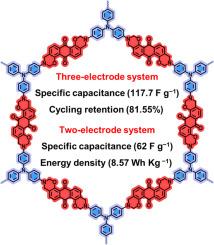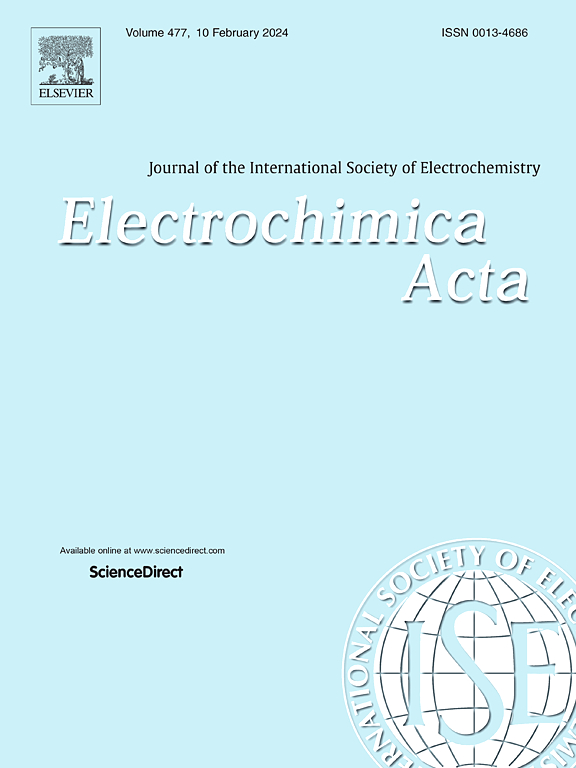用于高性能超级电容器的富含异构体的蒽醌基苯并恶嗪连接多孔有机聚合物的单锅合成技术
IF 5.5
3区 材料科学
Q1 ELECTROCHEMISTRY
引用次数: 0
摘要
最近,人们开始寻求高效耐用的储能电极,这促使了新型多孔有机聚合物(POPs)的开发。在这里,我们研究了一组新型蒽醌基苯并恶嗪连接 POPs 作为超级电容器(SC)电极材料的设计、制备和综合表征。这些聚合物是通过各种三胺、二苯酚和多聚甲醛的直接偶联合成的,产量很高。利用傅立叶变换红外光谱、固态 13C NMR 和 N2 吸附分析,可以很容易地分析苯并恶嗪连接的形成和孔隙率参数。苯并恶嗪骨架为持久性有机污染物提供了丰富的氮氧杂质原子,使其成为储存能量的有效候选物质。我们观察到,在 1.0 A g-1 的条件下,苯并恶嗪连接聚合物的电化学电容最大,可达 117.7 F g-1,这主要归功于 An-TPA 持久性有机污染物与其他聚合物相比具有最微孔的结构、最易获得的形态和最大的比表面积。此外,它在 10,000 次充放电循环后的保持稳定性最高(81.55%),欧姆电阻也较低(5.38 Ω)。有趣的是,含有 An-TPA POP 的双电极系统在 1.0 A g-1 条件下显示出 62 F g-1 的优异电化学电容,在 10 A g-1 条件下进行 5000 次 GCD 循环后显示出 95.71% 的更高循环保持率,以及 8.57 W h kg-1 的最大能量密度。研究结果表明,为下一代太阳能电池构建富含杂原子的持久性有机污染物具有重要意义,可提高效率和稳定性。本文章由计算机程序翻译,如有差异,请以英文原文为准。

One-pot Synthesis of Heteroatom-rich Anthraquinone-based Benzoxazine-linked Porous organic polymers for high performance supercapacitors
Recently, the search for efficient and durable electrodes for energy storage has prompted the development of novel porous organic polymers (POPs). Here, we have studied the design, preparation and comprehensive characterization of a novel set of anthraquinone-based benzoxazine-linked POPs as electrode materials for supercapacitors (SCs). The polymers with high yield have been synthesized by direct coupling of various triamines, diphenol and paraformaldehyde. The benzoxazine linkage´s formation and porosity parameters were readily analyzed using FTIR spectra, solid-state 13C NMR and N2 sorption analysis. The benzoxazine backbone provides the POPs with abundant nitrogen and oxygen heteroatoms, making them efficient candidates for storing energy. We observed that the superior benzoxazine-linked polymer exhibited the greatest electrochemical capacitance up to 117.7 F g‒1 at 1.0 A g‒1 was the An-TPA POP, which was mainly owing to the most microporous structure, accessible morphology and the largest specific surface area compared to others. In addition, it possessed the highest retention stability after 10,000 charge-discharge cycles (81.55%), as well as lower ohmic resistance (5.38 Ω). Interestingly, a two-electrode system holding the An-TPA POP displayed an excellent electrochemical capacitance of 62 F g−1 at 1.0 A g−1, a greater cycling retention of 95.71% after 5000 GCD cycles at 10 A g−1, as well as a prime energy density of 8.57 W h kg–1. The results obtained demonstrated a significant tactic for constructing heteroatoms-rich POPs for next-generation SCs, offering improved efficiency and stability.
求助全文
通过发布文献求助,成功后即可免费获取论文全文。
去求助
来源期刊

Electrochimica Acta
工程技术-电化学
CiteScore
11.30
自引率
6.10%
发文量
1634
审稿时长
41 days
期刊介绍:
Electrochimica Acta is an international journal. It is intended for the publication of both original work and reviews in the field of electrochemistry. Electrochemistry should be interpreted to mean any of the research fields covered by the Divisions of the International Society of Electrochemistry listed below, as well as emerging scientific domains covered by ISE New Topics Committee.
 求助内容:
求助内容: 应助结果提醒方式:
应助结果提醒方式:


